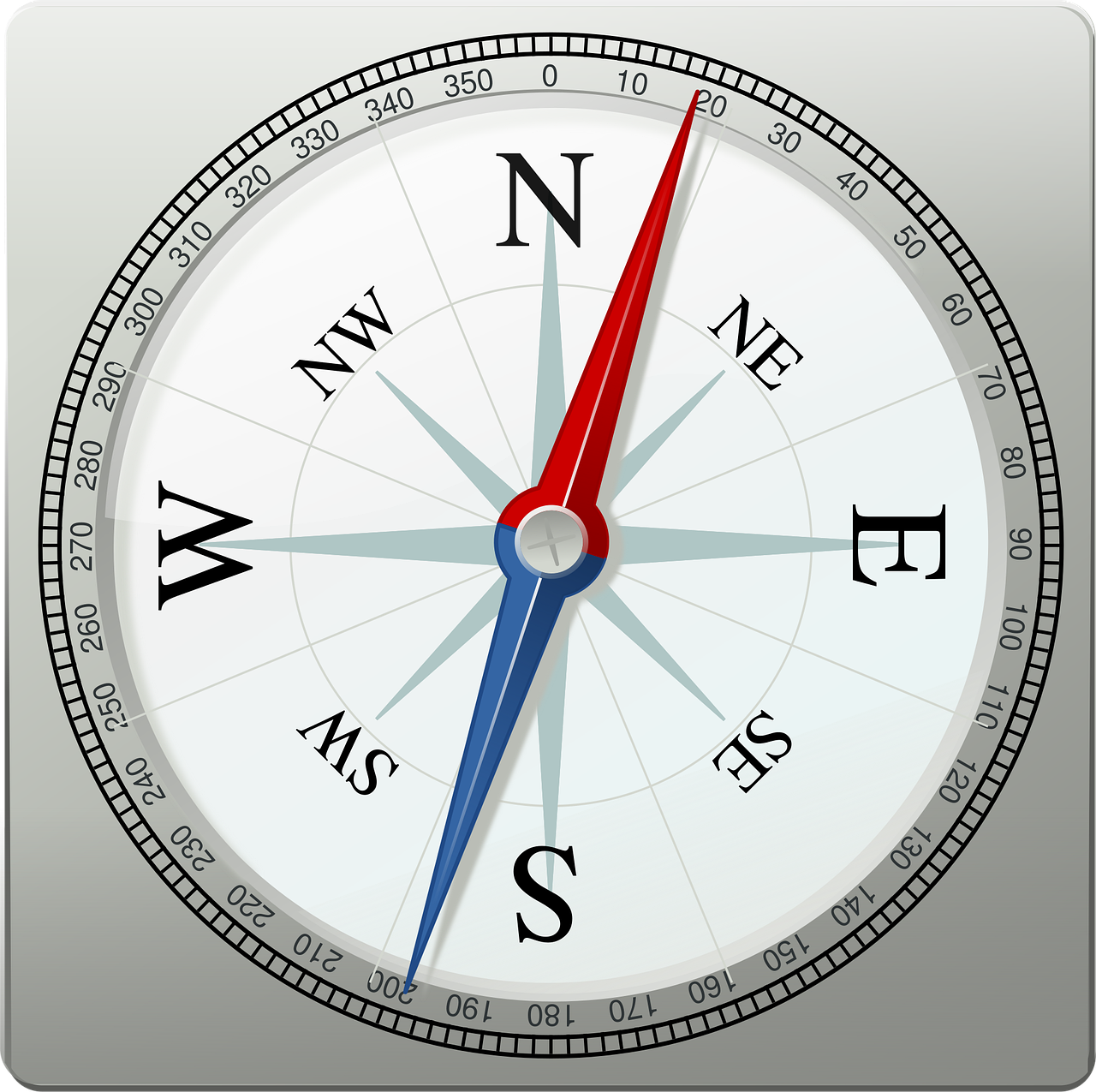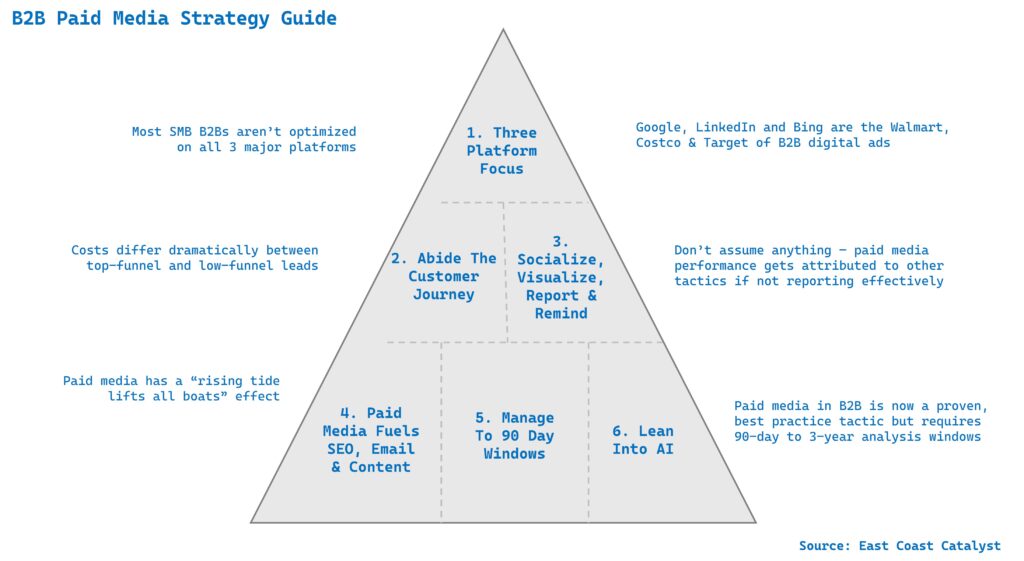B2B Paid Media Strategy Guide
Six factors for B2B marketers to consider when developing paid media strategies.

NEED TO KNOW
- Three platforms do most of the work in B2B: Google, LinkedIn and Bing
- Paid media can drive performance in all areas of the funnel
- Cost prohibitive for many B2Bs, paid media is now an industry best practice
- Paid media has accretive effect on most other marketing tactics
- AI is making paid media easier to manage but conditions more competitive
The digital marketing ecosystem is undergoing major changes in response to AI and soft economic conditions. The difference between success and failure for many B2B inbound marketing programs can rely on the performance of paid media campaigns. Here are six factors for B2B marketers to consider when formulating B2B paid media strategies.

1. Be World-Class On Three Platforms
It’s human nature to want to be the first to adopt a new successful method, which is why B2B marketers spend so much time answering questions like “Should we be advertising on [insert newest platform here]?” The answer to these anodyne questions is almost always “we should run a few tests to find out”.
At the same time, the B2B digital advertising ecosystem is at least a decade old and best practices have been established. Google, LinkedIn and Microsoft/Bing have emerged as the unequivocal leaders in the category — the Walmart, Costco and Target of the business. For the overwhelming majority of B2B companies, success on these platforms will translate to favorable business results — quality inbound leads — and positive ROI. Getting good and staying good on these platforms is a massive undertaking that requires focus, skills and budget to accomplish.
Takeaways: Getting a marketing team focused on these platforms isn’t a big challenge for senior B2B managers — getting the executive team buy-in on the strategy is another matter altogether.
2. Command The Funnel
Not all inbound leads are created equal, and their costs typically reflect that reality. A low-funnel lead is closer to making a purchase, doesn’t require months or years of nurturing, and evokes a visceral response from sales teams. That makes low-funnel leads more valuable, and expensive, than high-funnel leads.
A standard B2B marketing view of lead management is via the funnel and/or scoring models, and both are useful and need to be top-of-mind with B2B marketing teams. This is especially true with lead scoring since it’s what many sales teams use to gauge inbound quality and it’s almost always preferable for marketing teams to be calibrated with sales.
Effective B2B paid media strategies have funnel-like principles at their core, are measuring output in a way that aligns with funnel management, report performance regularly (monthly, quarterly, etc.), and are constantly educating audiences about methods and why they are important.
Takeaways: The B2B buyer’s journey is a “long, hard slog” but the industry has made meaningful progress over the past decade in standardizing methods and funnel management practices are one example.
3. Socialize, Visualize, Report & Remind
It wasn’t that long ago — maybe five years? — when marketing dashboards were considered a novelty. No more. Today, data visualization and dashboards go together with digital advertising like hot dogs, apple pie and baseball.
As a rule of thumb, B2B marketers spend as much time compiling performance reports as we do on the work itself. And it makes sense: with more investment dollars comes more scrutiny, and the B2B ads category is growing aggressively as more companies discover its effectiveness.
One of the biggest ongoing challenges for B2B paid media managers is reporting on ROI. B2B sales cycles are typically monthslong, non-linear, and messy. Attribution is hard under the best circumstances and that’s before competing groups within the organization — sales, marketing, customer success, customer service — chime in with their POVs and how and why a new piece of business was realized.
The best that B2B marketing managers can do in this environment is proactively set the reporting narrative, deliver regular and exhaustive performance reports, and build (selective) dashboards that allow 24/7/365 self-service.
Takeaways: Like Major League Baseball, the digital marketing industry is overrun with statistics, most of them with limited usefulness; but it’s preferable to overinform stakeholder audiences with data and deal with the follow-up questions than the alternative.
4. Rising Tide Lifts All Boats
The industry continues to wrestle with attribution but we B2B advertisers know the following to be true, even if we struggle to offer much evidence: paid media is the tide that lifts all other digital marketing tactic boats — including SEO, email, content marketing and engagement.
The theory is easy to understand even if the performance is difficult to prove with absolute precision: having quality ads served up to an audience at the exact moment a signal is being sent — via a keyword search, for example — is a powerful tactic. As is following them around the internet with retargeting ads. This is especially relevant for B2B, where impulse buys are unusual. So even if the ad isn’t acted on — clicked — in the moment, it has longer-term, subtle effects in the form of brand awareness and recall.
Even with all the right tools and analysts in place, attribution is an inexact science in the B2B marketing game, primarily because the buying journey can realistically include a dozen touchpoints by everyone on a steering committee whose members might be able to fill a minibus. Anecdotally, we recently did a three month “go dark” paid media test with a client and inbound lead volume decreased by 35%, though paid media had only accounted for 20% of leads during the prior two years.
Pro Tip: Paid media budgets are easy pickings for cost-cutting initiatives because they often run in the background or are misunderstood. It’s in the best interest of B2B marketers to address these challenges head-on and advocate for paid media when it makes sense.
5. Adjust Expectation Windows
B2B sales cycles are long. It’s not unusual for a vendor to be on a prospect’s radar for years before they take action. This reality means that B2B marketing executives need to get creative when reporting on performance. This is mostly a solved problem involving terms like “new member”, “MQL” and “Closed/Won” that allow for a common language to be used when explaining short term performance.
But it’s also important to keep an eye on the big prize: new customer business. A prospect might’ve been driven to the company website years ago after clicking an ad, signed up for a newsletter or followed a social media feed, and only recently requested a sales consult. Systems like Hubspot or Marketo help us to keep track of this activity but keeping this topic alive and top-of-mind is the job of B2B marketing executives. No one wants to hear about what happened two or three years ago so the narrative needs to be jazzed up but the reality is that many B2B marketing efforts require a couple of years to determine their efficacy and aspects of paid media fall into that category.
Takeaways: At larger or digitally-savvy B2Bs, paid media is now a standard line item so expectation management isn’t as much of an issue, like it is at SMBs, which often ascribe a “what have you done for me lately?” ethos to marketing.
6. Lean Into AI
AI has arrived and is here to stay. It’s impossible to say where it’s at in the Gartner Hype Cycle as of summer 2025, but it feels like it might be peaking.
AI will eventually be overrun by the next tech trend to come down the pike — see: Web 3.0, blockchain, wearables, augmented reality — but its usefulness has been proven and it will live on in the marketing stack. AI’s long-term impact will likely be more akin to cloud computing, big data and video conferencing in that it evolves into a tool we use daily but don’t think much about.
In the meantime, B2B paid media professionals are heads-down deploying AI-fueled tactics in the areas of ad units, landing pages, signal capturing and optimization efforts. New tools are cropping up weekly and can help on the margins but the fundamentals of paid media have remained largely unchanged – we need to be using every tool available to us to outmaneuver the competition.
Practically speaking, AI adoption hasn’t required a tectonic shift by paid media specialists because AI-like functionality has been a big part of platforms like Google Ads and Microsoft/Bing Ads since the get-go. We’ve been relying on AI and machine learning to optimize paid media campaigns for years, but haven’t been talking about it much. That’s all changed over the past year.
Takeaways: AI’s biggest impact on the B2B paid media landscape is that it’s made the entire ecosystem more competitive. The cost of producing machine generated content has dropped to nearly $0, resulting in a noisier environment, making it more difficult for ads to break through.
#############################################
RESOURCES & FURTHER READING
- B2B Digital Marketing Case Studies
- Does PPC Work For B2B?
- B2B Marketing Analytics
- AI & PPC Management
Tim Bourgeois is a B2B PPC specialist at East Coast Catalyst and manages the PPC management services practice. Contact him at tbourgeois(a)eastcoastcatalyst.com to discuss how his team can help with B2B digital marketing strategy and lead generation initiatives.
